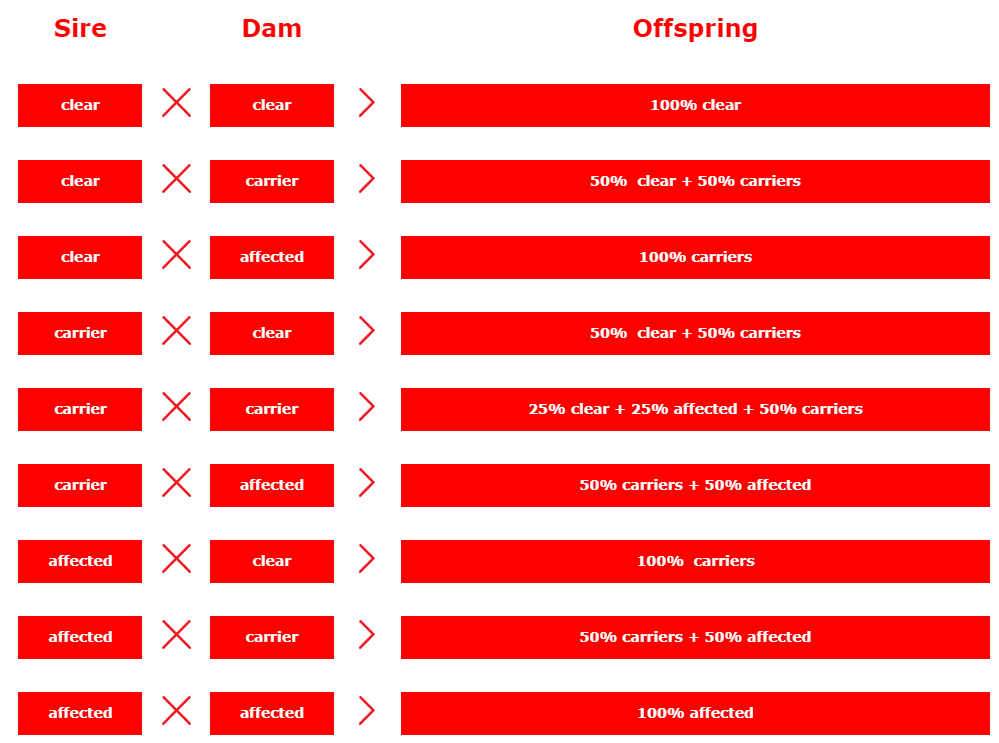Each elbow joint x-ray is assessed by BVA/KC scrutineers and the degree of elbow dysplasia present is indicated by a scale of 0 to 3 (0 being the best and 3 being the most severe). Only the highest grade of the two elbows is taken as the elbow grade for that dog.
Further information can be found here
There are now a wide range of DNA tests that are available for most breed of dogs, however only a limited few will be breed specific to your chosen breed.
When choosing a laboratory makes sure their results are recognised by the Kennel Club, this information can be found here.
Most tests will give you one of these three results:
Normal \ Clear The dog doesn’t have the gene for the tested disease and will never develop it.
Carrier The dog carries the gene for the tested disease but can never develop it.
Affected The dog has the affected gene, and has the chance of developing the tested disease. This is an important point, because your dog has tested affected for a disease it doesn’t mean symptoms or the diseases are present at this time. Some disease we test for do not take affect until the dog is much older.
Some affected dogs many never show signs of the tested disease but obviously it is a possibility.
If you are thinking of breeding the table below can help to choose a suitable match.
The only gene we are wanting to stay away from is the affected gene, it would be impossible to eradicate every dog that came back as a carrier or an affected as this would shrink most gene pools in most breeds.

The British Veterinary Association have a hereditary eye disease screening programme. The scoring system categorises the eyes as either ‘affected’ or ‘unaffected’ for a range of conditions. The test is only indicative of the state of the eyes at the time of screening. Some conditions may show no clinical signs until later on in life, so dogs used for breeding should be tested annually.
To read more on the eye testing click here.
Hip scoring is a procedure used to determine the degree of hip dyplasia in dogs.The hip score is the sum of the points awarded for each of nine radiographic tures of both hip joints.The British Veterinary Association uses the following criteria to determine hip score:
- Norberg Angle
- Subluxation
- Cranial Acetabular Edge
- Dorsal Acetabular Edge
- Cranial Effective Acetabular Rim
- Acetabular Fossa
- Caudal Acetabular Edge
- Femoral Head \ Neck Exostosis
- Femoral Head Recontouring
The lower the score, the less the degree of dysplasia present. The minimum (best) score for each hip is zero and the maximum (worst) is 53, giving a range for the total of 0 to 106.
Further information can be found here
Progressive Rod Cone Degeneration (PRCD) / Generalised Progressive Retinol Atrophy (GPRA)
The genetic disorder, prcd-GPRA , causes cells in the retina at the back of the eye to degenerate and die, even though the cells seem to develop normally early in life. The “rod” cells operate in low light levels and are the first to lose normal function. Night blindness results.
Then the “cone” cells gradually lose their normal function in full light situations. Most affected dogs will eventually be blind. Typically, the clinical disease is recognized first in early adolescence or early adulthood. Since age at onset of disease varies among breeds, you should read specific information for your dog.
Diagnosis of retinal disease can be difficult. Conditions that seem to be prcd-GPRA might instead be another disease and might not be inherited. OptiGen’s genetic test assists in making the diagnosis. It’s important to remember that not all retinal disease is GPRA and not all GPRA is the prcd form of GPRA. Annual eye exams by a veterinary ophthalmologist will build a history of eye health that will help to diagnose disease.
